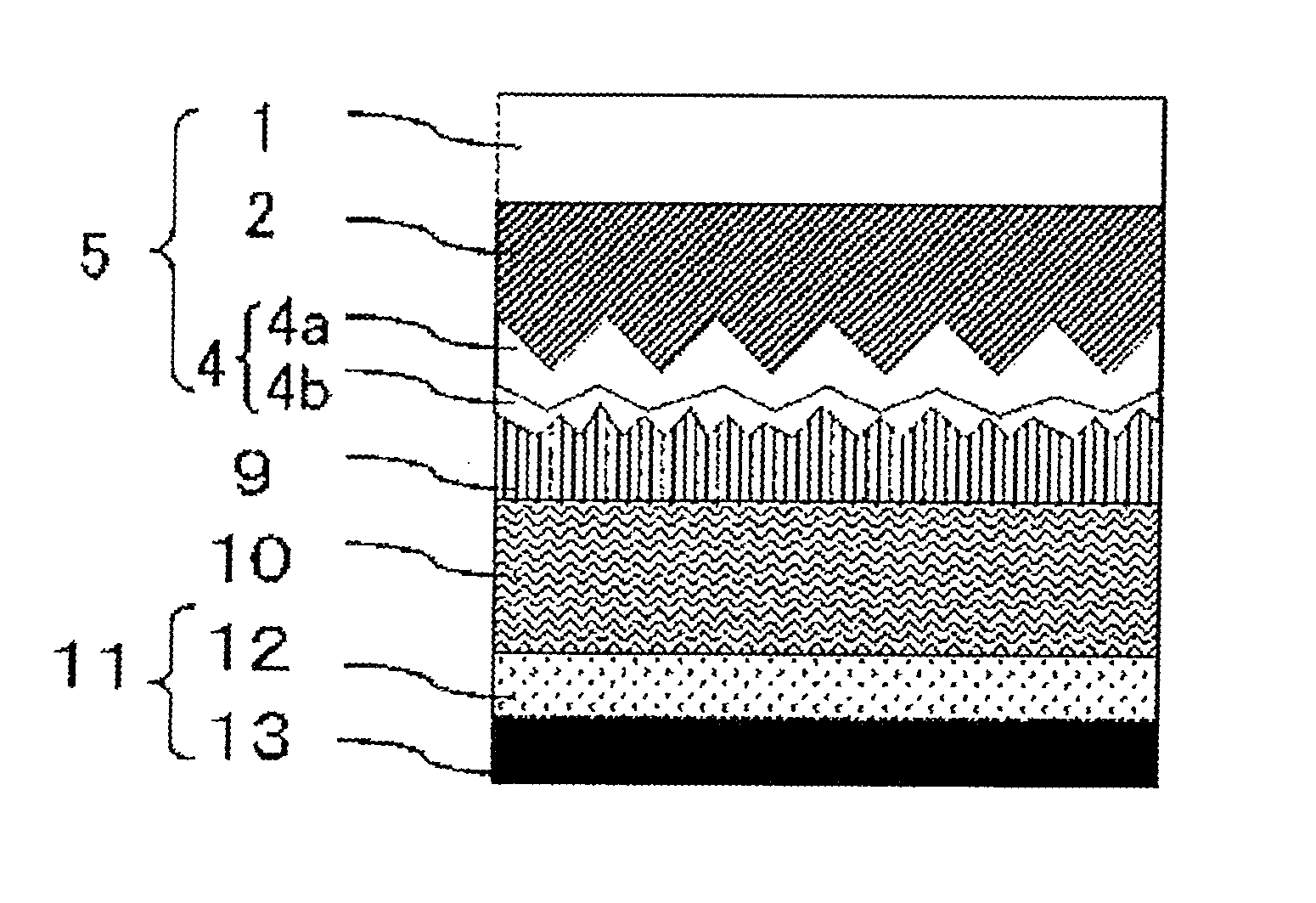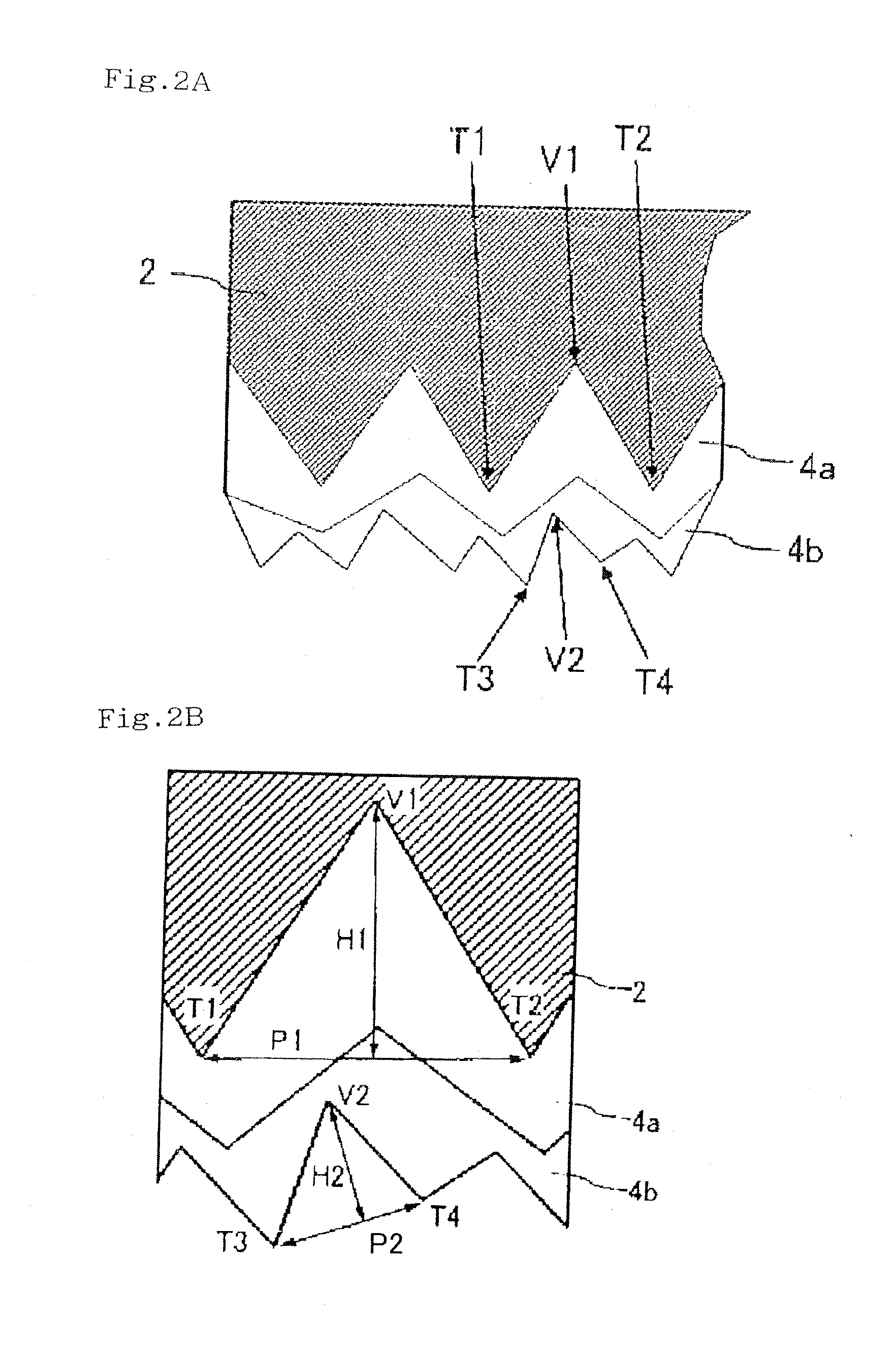Substrate with transparent conductive film and thin film photoelectric conversion device
- Summary
- Abstract
- Description
- Claims
- Application Information
AI Technical Summary
Benefits of technology
Problems solved by technology
Method used
Image
Examples
example 1
[0125]A double-junction type thin film photoelectric conversion device as illustrated in FIG. 3 was produced as Example 1.
[0126]First, an SiO2 layer was deposited, as an underlying layer 2, onto a glass substrate 1 having 0.7 mm thick and 125 mm square, by a sol-gel process. A coating solution used therefor was a SiO2 sol-gel solution (trade name: 512B, manufactured by Honeywell International, Inc.), which is used as an SOG material. A coating method used therefor was spin coating and the layer was formed into a film thickness of 1000 nm.
[0127]Next, the whole of the substrate on which the underlying layer 2 was formed was pre-baked on a hot plate at 60° C. for 20 minutes to semi-cure the underlying layer. Subsequently, the substrate was transported into an imprinting device to push, against the underlying-layer-2-formed substrate, a mold 3 in which an irregular structure of was formed in a surface of a monocrystalline silicon substrate. The irregularities were in the shape of pyrami...
example 2
[0138]A double-junction type thin film silicon solar cell was formed as Example 2 in the same way as in Example 1. However, in Example 2, the method for depositing a first transparent electrode layer 4a was different from that in Example 1.
[0139]First, an underlying layer 2 was formed onto a glass substrate 1 by a sol-gel method to form an inverse-pyramidal-irregular structure into the surface of the underlying layer by the same nano-imprinting method as in Example 1. The first transparent electrode layer 4a was deposited into a thickness of 1200 nm on the substrate on which the underlying layer was deposited by low-pressure CVD. At the time of the completion of the deposition, the supply of diethyl zinc, water, diborane, and phosphine as raw material gases was stopped, thereby interrupting deposition once. Thereafter, the raw material gases were again supplied to deposit a second transparent electrode layer 4b into a thickness of 400 nm.
[0140]AFM was used to observe the surface sha...
example 3
[0157]A double-junction type thin film photoelectric conversion device as illustrated in FIG. 3 was formed as Example 3. Example 3 was different from Example 1 only in that the first transparent electrode layer 4a was changed from zinc oxide to indium-titanium composite oxide.
[0158]In the same way as in Example 1, an underlying layer and an irregular structure were formed, and then indium oxide doped with Ti was deposited, as a first transparent electrode layer 4a, into a thickness of 300 nm onto the underlying layer by sputtering. Thereafter, a transparent electrode layer 4b was deposited into a thickness of 400 nm thereon by low-pressure CVD. In this way, a transparent conductive film 4 was deposited. The deposition of the transparent electrode layer 4b was performed by CVD under the same conditions as in Example 1.
[0159]AFM was used to observe the surface shape of the transparent conductive film. The top-bottom distance H2 of the irregular structure was 90 nm, and the distance P2...
PUM
 Login to View More
Login to View More Abstract
Description
Claims
Application Information
 Login to View More
Login to View More - R&D
- Intellectual Property
- Life Sciences
- Materials
- Tech Scout
- Unparalleled Data Quality
- Higher Quality Content
- 60% Fewer Hallucinations
Browse by: Latest US Patents, China's latest patents, Technical Efficacy Thesaurus, Application Domain, Technology Topic, Popular Technical Reports.
© 2025 PatSnap. All rights reserved.Legal|Privacy policy|Modern Slavery Act Transparency Statement|Sitemap|About US| Contact US: help@patsnap.com



